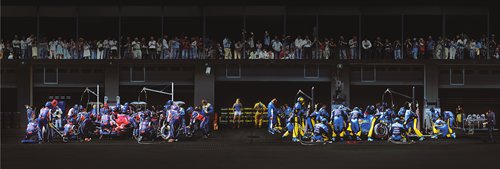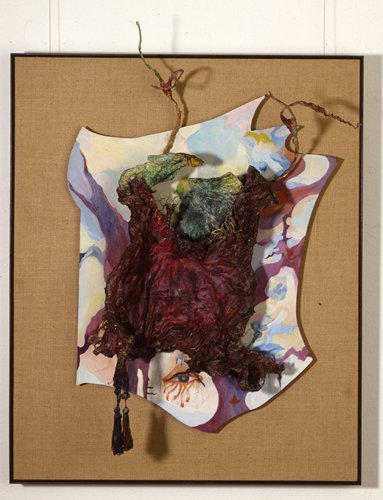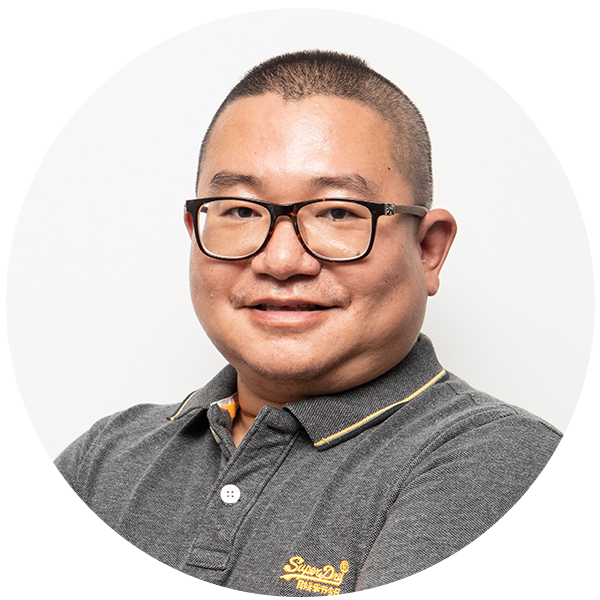
F1 Boxenstop III by Andreas Gursky Photo: Courtesy of Beijing Minsheng Art Museum

Migof by Bernard Schultze Photo: Courtesy of Red Brick Art Museum
It must be the largest showcase of contemporary German art in China. The ongoing Deutschland 8 - Deutshce Kunst in China Series exhibition is so large that seven museums in Beijing are needed to present the 320 works from 55 German artists.
The first art project approved by the High-Level China-Germany Person-to-Person Exchange Dialogue Mechanism during its debut meeting in May, the event is a key part of celebrations marking the 45th anniversary of diplomatic ties between China and Germany.
Reaching out
German art has always commanded a notable position in the history of art with its strong spirit and unique aesthetic. It has also greatly influenced contemporary Chinese art and the artists who create it.
According to Fan Di'an, president of the China Central Academy of Fine Arts and one of the two head curators for Deutschland 8, German art developed rapidly after World War II, leading to a group of important artists gaining international recognition. This development eventually became known as the German Art Phenomenon.
"It is a meaningful exhibition for both countries," he said.
Walter Smerling, the head curator from Germany, called the exhibition an "expedition into the cultural continent created by German artists since 1945… an essay on German art which avails itself of methodological freedom typical of essayistic investigations and explorations."
At a press event before the exhibition, Smerling recalled that it took nearly two years of planning to bring together all the works - which range from oil paintings and photos to sculptures and installation works - from a multitude of public museums, galleries and private collections.
Smerling noted that "a stable relationship between two nations is an important precondition for cultural exchange, while innovation in cultural exchange can launch new mechanisms and lead to new directions for mutual trust and discussion in many fields."
Michael Clauss, ambassador of Germany to China, stressed in a press release that Deutschland 8 is a very significant event for person-to-person exchange between the two countries.
"Art helps to overcome distances and can be used as a catalyst for improving understanding. The exhibition gives Chinese audiences and art lovers a rare opportunity to gain a deeper understanding of the richness and diversity of German art since the 1950s, opening the door for direct dialogue between Chinese and German artists," he said.
"Cooperation in person-to-person exchanges in recent years has pulled the hearts of our two peoples closer," Chinese President Xi Jinping said in a congratulatory letter to the High-Level China-Germany Person-to-Person Exchange Dialogue Mechanism back in May, according to a report from the Xinhua News Agency.
Deutschland 8 actually has very close ties to China, as the event was inspired by the 2015 exhibition China 8: Contemporary Art from China Along the Rhine-Ruhr, which showcased more than 500 works by 118 contemporary Chinese artists in nine museums across eight cities in the Rhine-Ruhr region of Germany. After visiting China 8, Joachim Gauck, former president of Germany, said in an interview that he hoped his nation would one day be able to hold a similar large-scale exhibition in China.
Co-organized by the Foundation of Art and Culture Bonn and the Central Academy of Fine Arts, Deutschland 8 is taking place as seven independent exhibitions and one forum at the Imperial Ancestral Temple Art Museum, Beijing Minsheng Art Museum, Red Brick Art Museum, Today Art Museum, Yuan Art Museum and the Whitebox Art Center.
Below is a brief introduction to four of the seven exhibitions.
Red Brick Art Museum: Prologue, German Art Informel
The exhibition focuses on the common characteristics of Art Informel, post-war German's most important abstract school of art, and the different explorations and choices these artist made as they confronted their personal artistic ideals. Works from six artists, created from 1950 to the 2000s, are on display. The works from the 1950s and 1960s in particular are rare pieces that reflect the influence of the global Art Informel movement.
Time: Until October 22 (Closed on Mondays)
Admission: 60 yuan
Beijing Minsheng Art Museum: Language of Photography and the Dusseldorf School
This exhibition focuses on German photography.
Highlights include Bern and Hilla Becher's industrial architecture photography series from the 1970s, which museum director Zhou Xujun noted had a great impact around the world. Other artists represented at the exhibition include Andreas Gursky and Thomas Ruff.
In addition to the Bechers' photo series, the exhibition also features a photo series of modern public architecture by Thomas Struth and Candida Hofer.
Time: Until October 22
(Closed on Mondays)
Admission: Free
CAFA Art Museum: Paradigm of Art: Contemporary Art from Germany
This exhibition showcases the works of 17 artists, who cover a vast range of artistic styles: Franc Ackermann with his travel collages, Horst Antes represents figurative paintings with his hallmark art-historical characteristics, while Stephan Balkenhol brings pioneering, roughly-hewn, painted wooden figures that are surreal depictions of people, animals and occasionally architecture.
Zhang Zikang, director of the CAFA Art Museum, said, "These artworks are important because they shatter paradigms. The majority of these artists were not content with painting or sculpture in the traditional sense. They extended their creative visions into more diverse and mixed media."
Time: Until October 29,
(Closed on Mondays)
Admission: Free
Today Art Museum: Arrested Time: New Media Art from Germany
The exhibition focuses on artworks by seven of the most important and active new artists in Germany, including Harun Farocki, Julian Rosefeldt and Julius Popp.
According to Gao Peng, director of the Today Art Museum, the exhibition highlights the characteristics of new media art represented by video art to show how these artists extract the elements of artistic creation from life, taking personal experiences, scenes and slices of life as their subjects and imbuing their work with cultural significance and critical spirit.
"It offers us an opportunity to examine post-war German art based on a specific subject and to present a complete and unique German video art viewing experience to the Chinese public," he said.
Time: Until October 31
(Closed on Mondays)
Admission: Free

